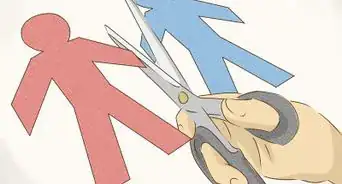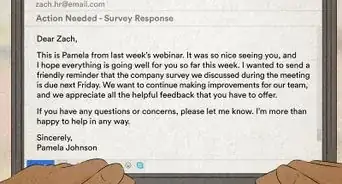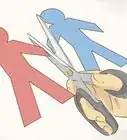This article was co-authored by Frank Blaney. Frank Blaney is a Certified Qigong and Tai Chi Instructor with over 15 years of teaching experience. Passionate about making Qigong more accessible to people, Frank is the author of "Qigong: The Quick & Easy Start-Up Guide." He also holds a 2nd Degree Black Belt in Jujitsu and trains executives and staff of corporations, NGOs, and communities in self-care, personal performance and conflict resolution. He holds an MA in Negotiation, Conflict Resolution, and Peacebuilding from California State University Dominguez Hills.
There are 25 references cited in this article, which can be found at the bottom of the page.
This article has been viewed 11,557 times.
Toxic masculinity is more than just acting 'like a man'. Instead, it refers to the extreme pressure that some men may feel to act in a harmful manner. Toxic masculinity is the idea that some people's definition of "manliness" perpetuates domination, homophobia, and aggression. Toxic masculinity refers to cultural pressures on men to act in certain ways. And it's very likely that this affects all boys and men in some way. This article will teach you how to combat toxic masculinity and how to avoid toxic masculinity in yourself.
Steps
Understanding Toxic Masculinity
-
1Understand what toxic masculinity actually is. Toxic masculinity, in general, is an adherence to the limiting and potentially dangerous societal standards set for men and people who identify as masculine. The term was created in the late 80's, but became popular in the 21st century. The term 'toxic masculinity' refers to how certain masculine traits harm men while also harming women and others. [1]
- Toxic masculinity may also assume that all men are straight and cisgender, and that this is the way they should be – which is obviously not the case. It is important to note, however, that gay and trans men can exhibit toxic masculine characteristics.
-
2Acknowledge the main components of toxic masculinity. As individuals, we need to be in a constant state of examining what kind of gender indoctrination we have received. [2]
- Toughness: the idea that men should be physically strong, emotionally callous, and aggressive in their behavior.
- Antifeminity: the belief that men should reject anything considered feminine, such as expressing emotion or accepting help.
- Power: the assumption that men must strive for power and status (both social and financial) in order to gain the respect of others.
Advertisement -
3Understand the dangers of toxic masculinity. Toxic masculinity promotes unhealthy extremely unhealthy behaviors and habits. Many are listed here:
- Men are discouraged from seeking mental health treatment as a result of toxic masculinity. Research has found that men are less likely to seek medical attention when it is necessary because they are afraid of appearing weak or incapable of providing for their families.[3] Depression, anxiety, substance abuse, and mental health issues may be viewed as signs of weakness, and since toxic masculinity discourages men from seeking medical attention, in addition to pushing them physically, this is linked to higher rates of suicide in men.
- Assumptions that men should be protectors, breadwinners, or leaders, or associating men with anger, selfishness, and aggression, can be problematic and damaging.
- When men actively avoid vulnerability, act on homophobic beliefs, ignore personal traumas, or engage in prejudiced behavior toward women, they contribute to a wide range of societal issues, including gender-based violence, sexual assault, and gun violence.[4]
- Toxic masculinity ideology treats women as sexual conquests, which contributes to ongoing issues such as rape culture. This refers to the tendency to shift blame away from sexual assailants and onto the victim.
- When it comes to kids roughhousing, the phrase "Boys will be boys" may appear harmless. However, it has the potential to devolve into justifications for violent behavior or a failure to respect boundaries.
-
4Notice examples of toxic masculinity. Many toxic phrases, actions, and behaviors can be seen as toxic masculinity include:[5] [6]
- Phrases such as, "man up,” “toughen up,” or "grow some balls"
- Possessing characteristics such as promiscuity, aggression/violence, and dominance.
- Remarks such as "boys will be boys," "no homo," "boys don't cry", and “I’m a guy, we’re not good at that stuff/what do you expect?”
- Engaging in risky behavior, such as having multiple sexual partners, getting into physical fights, drinking, or drug abuse.
-
5Understand toxic masculinity promotes sexism and misogyny. Positive or healthy masculinity is not sexist. It does not discriminate against people who identify as a different gender or sexuality than the man, and it has no aversion to admitting emotions and vulnerability.[7]
-
6Realize that toxic masculine encourages homophobia. Promoting heterosexuality as the unalterable norm, alongside cisgenderness. Attraction to a cisgender, straight woman is the societal standard for masculinity; anything that resembles something other than masculinity, such as affection for a masculine friend or being LGBTQ, is viewed as a threat to masculinity. Not only that, but 85 percent of LGBTQ students reported being verbally harassed at school because of their gender expression or sexual orientation, according to the 2015 National School Climate Survey. [8]
- It's also worth noting; gender nonconforming students reported receiving worse treatment than students who identified as LGBTQ while conforming to traditional gender norms.
-
7Recognize that toxic masculinity encourages racism. The race and ethnicity of men may influence how they perceive masculinity as well as how others perceive them. Boys of all races and ethnicities who do not act "masculine enough" may face harassment at school. A study found that Asian-American men are perceived as less 'manly' than white or Black American men among white college students. [9]
-
8Understand how toxic masculinity provokes mental health concerns. In 2018, men were significantly more likely than women to die from an opioid overdose. Men are far more likely than women to commit suicide. Anxiety, depression, and mental illness affect men just as much as all genders. Men are more likely than to decline mental health services, such as therapy, and they are more hesitant to seek help, particularly with regard to mental health.
Ending Toxic Masculinity in Yourself
-
1Learn to be vulnerable. Through the lens of toxic masculinity, vulnerability is equated with weakness. Accepting that you are vulnerable leads to emotional awareness, which leads to being more empathetic to yourself and others emotions and feelings. Dare to be vulnerable. Cry to show your strength. Do this with the understanding that all men experience emotional ups and downs. Be the person your friends open up to when they need support. It is true that if one man shows that it is acceptable to do something, the rest of us, as pack animals, tend to follow. [10]
-
2Notice the line between toxic masculinity and masculinity. There is a distinction between traditional masculinity and toxic masculinity: working hard, providing for one's family, winning sports, or being loyal to friends are not toxic. Wanting to be respected is not a toxic emotion. We all want to be respected—to know that we are valued, recognized, and affirmed. Where masculinity crosses the line, is a glorification for glorification or violence, the need to dominate others, sexual aggression and control, homophobia, and misogyny. Toxic masculinity is ultimately about having power over others, whether that power is over women, other men, or groups of people they perceive to be weaker or less important. [11] [12]
- Toxic masculinity is the result of teaching boys that they cannot openly express their emotions; that they must be "tough all the time"; and that anything less than that makes them "feminine" or weak. This does not imply that all men are toxic by nature.
-
3Perform kind gestures every day. The more generous you are, the more actively you care for others, and the more you look outside yourself, the more anti-toxic gas is released into the air. By demonstrating how to be a good person, you are not only demonstrating what can be done, but also spreading the word.
- Open the door for others, let someone in line go in front of you when you aren't in a rush, or give someone a sincere compliment. These are a few examples of nice gestures.[13]
-
4Have difficult conversations. Ask your friends — particularly those who have different gender identities and expressions than you — about how you handle difficult situations or masculinity biases. Try not to become defensive, and instead pay close attention to how your actions have affected others. You may be surprised that certain things you did or said did not come across as you intended.
Fighting Toxic Masculinity
-
1Protest toxic sellers. By boycotting any brand that promotes the wrong message, you can put an end to stereotypes. Simply put, don't buy products that claim to help you become invincible, unbreakable, impenetrable, or anything else. Cut off the money supply to those who perpetuate overly masculine products.[14]
-
2Combat gender roles. Expanding and integrating new concepts into an individual's definition of masculinity may help them better understand and accept themselves and others. Stereotypes and gender roles won't go away unless people recognize how harmful they are. Risks for cisgender girls include child marriage, pregnancy, dropping out of school early, sexually transmitted infections, and exposure to violence. Cisgender boys, like women, face an increased risk of substance abuse, suicide, and a shorter life expectancy – especially if they challenge masculine norms. If you have or know children, demonstrate and encourage them that regardless of their gender, they can pursue any job, action, or express feelings. [15] [16]
- Masculine identifying people can take care of kids, cook, and clean; while still being masculine. Feminine identifying people can be providers (breadwinners), leaders, and protectors while still being feminine.
-
3Get professional help if you need it and encourage the same for others. Contact your primary care physician if you are experiencing unhealthy or toxic masculinity. If they are unable to assist, seek the assistance of a mental health professional who specializes in male therapy or gender identity issues. You can also encourage people who are toxic to look for help from a mental health professional. [17]
-
4Challenge toxic masculinity. Combating toxic masculinity can help men improve their mental health while also creating safer spaces for women and non-binary individuals. You can do this by talking about it, speaking up when you hear something you know is wrong, and challenging your own assumptions about how people 'should' behave in society.[18]
-
5Teach boys to express their emotions. When they're upset, don't humiliate them. Teaching boys resilience is not the same as teaching them to conform to preconceived notions of what a boy should be; all you are doing by teaching them toughness is narrowing their perspective, confining them to a space in an old shed, and crushing their spirit. Resilience, on the other hand, is about feeling those feelings in a genuine way, understanding and harnessing them rather than denying their existence. Encourage them to talk to someone (or you) if they are going through a difficult time, and to express their emotions. [19]
-
6Take action to toxic masculine behaviors. When two boys are physically fighting, don't dismiss it with the typical "boys will be boys"--break up the fight. Don't keep quiet in the face of it. When the topic of "getting in" a girl's pants comes up in your male group, that's not a cue to turn the other cheek. Speak up and say something when you see toxic masculinity. Don't let the toxicity get out of hand. This is social conditioning, not just "the way men are" – individuals must break free from this way of thinking.
- Remember: no one is born a misogynists or homophobe; rather, humans are socialized from a young age as to what a man should and should not be, and we are taught to reject the 'other.'
References
- ↑ https://www.healthline.com/health/toxic-masculinity
- ↑ https://www.verywellmind.com/what-is-toxic-masculinity-5075107
- ↑ https://www.healthline.com/health/toxic-masculinity#health-effects
- ↑ https://www.verywellmind.com/what-is-toxic-masculinity-5075107
- ↑ https://www.aurorand.org.uk/news/top-10-toxic-masculinity-behaviours
- ↑ https://www.claritychi.com/how-to-be-masculine-without-being-toxic/#
- ↑ https://greenhillrecovery.com/toxic-masculinity-vs-healthy-masculinity/
- ↑ https://www.verywellmind.com/what-is-toxic-masculinity-5075107#toc-race-ethnicity-and-gender
- ↑ https://www.verywellmind.com/what-is-toxic-masculinity-5075107#toc-race-ethnicity-and-gender
- ↑ https://www.edgar.ae/articles/how-to-identify-and-deal-with-toxic-masculinity
- ↑ https://www.claritychi.com/how-to-be-masculine-without-being-toxic/
- ↑ https://www.scientificamerican.com/article/how-to-fight-toxic-masculinity/
- ↑ https://www.verywellmind.com/the-dangerous-mental-health-effects-of-toxic-masculinity-5073957
- ↑ https://thebookofman.com/mind/masculinity/10-things-to-end-toxic-masculinity/
- ↑ https://www.bonobology.com/traditional-gender-roles/
- ↑ https://www.edgar.ae/articles/how-to-identify-and-deal-with-toxic-masculinity
- ↑ https://greenhillrecovery.com/toxic-masculinity-vs-healthy-masculinity/
- ↑ https://spunout.ie/life/bullying/what-is-toxic-masculinity
- ↑ https://thebookofman.com/mind/masculinity/10-things-to-end-toxic-masculinity/
- https://www.nytimes.com/2019/01/22/us/toxic-masculinity.html
- https://www.verywellmind.com/the-dangerous-mental-health-effects-of-toxic-masculinity-5073957
- https://www.healthline.com/health/toxic-masculinity#addressing-it
- https://www.verywellmind.com/what-is-toxic-masculinity-5075107#toc-helping-behavior
- https://www.weforum.org/agenda/2019/03/beat-gender-stereotypes-learn-speak-up-and-react/
- https://greenhillrecovery.com/toxic-masculinity-vs-healthy-masculinity/
- https://www.edgar.ae/articles/how-to-identify-and-deal-with-toxic-masculinity
- https://spunout.ie/life/bullying/what-is-toxic-masculinity
- https://www.scientificamerican.com/article/how-to-fight-toxic-masculinity/
- https://thebookofman.com/mind/masculinity/10-things-to-end-toxic-masculinity/
- https://www.claritychi.com/how-to-be-masculine-without-being-toxic/#







-Step-11.webp)






-Step-2.webp)


-Step-17.webp)



























































